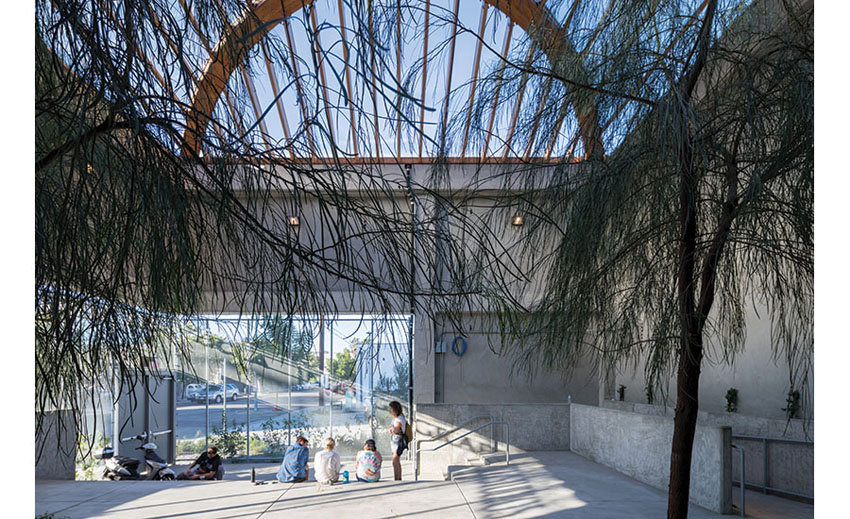Colleges & Universities
Mui Ho Fine Arts Library | Ithaca, New York | STV and Wolfgang Tschapeller
Levitation Room
An early 20th-century building, once home to architecture studios, is transformed into Cornell University’s new fine-arts library.
BY ALEX KLIMOSKI
For over a century, Rand Hall, a three-story 1911 yellow-brick building at the northeast corner of Cornell University’s Arts Quad in Ithaca, New York, was defined by its industrial fenestration—a grid of generously sized steel casement windows. Formerly home to undergraduate and graduate architecture studios, Rand’s operable single-glazed openings revealed to passersby the messy vitality of students hard at work. The building ceased functioning as such when the adjacent Milstein Hall, the expansive, dramatically cantilevered structure designed by OMA (RECORD, February 2012) became the architecture department’s new, state-of-the-art academic hub. Now Rand’s large apertures have been retrofitted with monolithic, highly reflective 12-foot-wide double-glazed windows, which lend the facade a more austere, and slightly surreal aesthetic—an outward expression of the new 26,650-square-foot Mui Ho Fine Arts Library it now houses.

PHOTOGRAPHY: © LUKAS SCHALLER (LEFT); CHRIS COOPER
FLOAT ON A system of steel shelves (left) and catwalks was suspended from the roof to create a buoyant effect. The armature is tied to the slab with sway-control cables. The early 20th-century building’s apertures were retrofitted with fixed double-glazed windows (right).
The completion of Rand Hall’s renovation in August was the last step in a series of reconfigurations within the college of Architecture, Art, and Planning (AAP) prompted by the construction of Milstein. For many years, the fine-arts library had been in the two-story space below the dome of Sibley Hall—a classical-style building bordering Milstein—which has been converted by New York–based LevenBetts into administrative offices, crit and pinup spaces, and student workstations. In 2014, with a $6 million gift commitment from Mui Ho—a Berkeley-based architect and former educator who received her B.Arch. from Cornell—then-dean Kent Kleinman invited four architecture firms, including Herzog & de Meuron, to submit proposals to renovate Rand. The brief included the relocation of the library to its upper two levels—which connect to Milstein’s studios—and the conversion of 8,000 square feet on the ground level into new fabrication shops and makerspaces. Vienna-based architect and AAP alumnus Wolfgang Tschapeller was selected for his idea of having the stacks appear as a towering volume levitating within a cavernous space.
Achieving the floating effect required a major structural intervention, which simultaneously made the historic building compliant with current codes, including those for seismic and wind loads. The ground level’s column grid and the floor slab above it were left intact, while the second and third levels were gutted, removing the upper slab and the vertical structure to create a singular 40-foot-high light-filled space. The roof line was raised 7 feet above the previous sawtooth configuration’s lowest point, and a new system of 20 steel beams that span 50 feet from the north to south exterior walls was installed. Vertical steel hangers, to which three levels of shelves are fastened, are suspended from the nearly 2-foot-deep beams, which also support tie-down hooks that accommodate outdoor installations on the rooftop. A spine of replacement columns, hidden between the stacks, supports the beams. To handle the redistribution of loads, the architects embedded a steel framework within the masonry facade, in between the window bays, and reinforced the foundation in certain areas.
Tschapeller, who worked with New York–based engineering and architecture firm STV, used a highly efficient mezzanine shelving system: each level is scaled according to the number of books, allowing for a capacity of more than 120,000 volumes. The steel armature, hovering 4 feet above the floor, is fastened to the slab only by sway-control cables. Grated catwalks permit ventilation within the stacks and allow access to the books, while the frame’s thin profile showcases the immensity of the library’s collection; two bridges—one on each of the upper shelf levels—connect the framework to Rand’s entrance atrium and egress stair. “Books are heavy, yet they contain knowledge, stories, and images, which are essentially weightless,” explains Tschapeller about the inspiration for his unusual design. “We wanted to construct a paradoxical situation—something with enormous gravity hanging from the skies.” The architect had previously used a floating shelving system for a library in the museum of Sigmund Freud’s apartment at Berggasse 19 in Vienna, although he cantilevered the shelves from the bearing walls there instead of hanging them from the roof.

PHOTOGRAPHY: © CHRIS COOPER
LINKED IN The OMA-designed Milstein Hall connects Rand and Sibley Halls, the two classical-style buildings that flank its east and west ends.

While the immovable shelving system glorifies the physicality and accessibility of books, the shifting programmatic requirements of libraries in the digital age are less considered. Even though the library will continue to acquire print volumes into the near future, the decision to purchase either print or electronic formats is decided partly on the basis of user need, says architecture librarian Martha Walker. However valuable physical books are in the dissemination of knowledge, continued improvements in processing and display technologies will probably reduce their necessity for future generations of students. But, given the very foundation of the library’s architecture holdings—which were built upon the extensive private collection of Andrew Dickson White, the university’s first president—the volumes now in Rand Hall are “especially valued because of their importance to the history and growth of Cornell,” says Carl A. Kroch University Librarian Gerald R. Beasley. The resulting project is a monument to the school’s illustrious legacy, but also to a single-minded design concept that, although meant to inspire students, does not represent a flexible 21st-century learning environment.

PHOTOGRAPHY: © CHRIS COOPER (LEFT); LUKAS SCHALLER ( RIGHT)
READING ROOM Individual desks at the stacks’ north end provide work areas for students. The shelving system, which hovers 4 feet above the floor slab, is accessed by stairs.
credits
Architect of Record: STV — David Miles Ziskind, principal in charge; Harris Feinn, project manager; David Scheck, project architect
Design Architect: Wolfgang Tschapeller — Niklavs Paegle, Christian Gattringer, Jürgis Gecys, Christina Jauernik, Gonzalo Vaillo Martinez, Bojana Vucinic, design team
Engineer: STV (m/e/p)
General Contractor: Welliver
Consultants: Transsolar (climate design); Fischer Marantz Stone, Pokorny Lichtdesign (light); Olaf Eigenbrodt (library)
Client: Cornell University
Size: 26,650 square feet
Completion date: August 2019
SOURCES
Structural Floor Grating: Progress Architektura
Metal Wall panels: Mitsubishi Alpolic
Glazed Aluminum Curtain Wall: Oldcastle BuildingEnvelope









